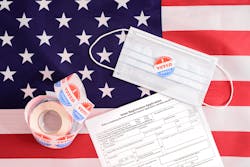The realities of security forecasting for the 2020 election
This election cycle includes the advent of the pandemic and societal unrest with businesses facing evolving threats like never before. Especially today, risk is constantly evolving. Understanding risk and vulnerabilities and proactively planning to minimize these risks are crucial to business continuity and employee and community safety.
An important aspect of forecasting potential security risks is the examination of historical instances of unrest tied to past elections and using them to form a predictive analysis about what locations are potentially most at risk.
Based on the past six months, influencers have proven their ability to quickly accelerate situations and motivate demonstrations. Many of these rapidly initiated demonstrations have lasted well over 30 days. Social media has dramatically increased the speed in which protests materialize.
An assessment of the current civil-political atmosphere aids in the analysis of near-future outcomes of unrest so that security firms are able to provide recommendations to mitigate the effects. Historical findings help complete the picture of the 2020 election environment with trends and contemporary analysis at the forefront; painting a clear path from where we are now, into what to expect during the election and beyond.
Key Findings
● The most prominent locations for demonstrators to gather are common governmental buildings (local, state, and federal) such as administrative buildings, courthouses, police departments and headquarters. Parks and well-known civic locations are also common.
● The following cities have sustained relatively long periods of consecutive protests during 2020: Washington DC, New York City, Chicago, Los Angeles, Seattle, and Portland. Minneapolis and Chicago being recent additions as cities of note.
● The states with the highest number of incidents of political and social violence and/or demonstrations in 2020 were: California (~1404), New York (786), Florida (652), Texas (568), and Pennsylvania (558).
● Delays and interruptions in commuting and travel during active civil unrest is very common. According to some reports, there have been as many as 700 incidents of demonstration led traffic obstructions in 2020 alone. There have also been more than 104 incidents of people driving vehicles into protests since May 27 of this year. These types of situations caused general widespread distress, subway delays, intermittent highway blockage (sometimes announced by media ahead of time if organized), and temporary suspension or re-routing of public bus services with little to no warning.
● There has been a total of 59 National Guard mobilizations in the U.S. since May 24 in response to demonstrations.
Based on trending information of past elections, as well as recent events, the primary threats will likely come in the form of protests, looting, and rioting.
Specifically, key metropolitan areas such as Washington DC, New York City, Chicago, Los Angeles, Seattle, and Portland that have presented rapid escalations of civil unrest, will continue to trend. Law Enforcement and National Guard resources have responded to this unrest will continue to fall under greater scrutiny as unrest escalates. The effect of rapid public escalation, pressure on enforcement agencies to provide latitude to demonstrators, and mounting agency resource constraints may lead to heightened events in multiple cities within a singular timeframe. Events such as the seizure of neighborhoods and/or key infrastructure (as observed in Seattle’s “CHAZ” or “CHOP” situation) may significantly degrade the non-protesting public trust in leadership and authorities and emboldens various groups in other cities.
It is unlikely that a single group, or coalition of groups, will be able to effectively organize national civil unrest. It is more likely these events will unfold in succession between November and January, in a rather uncoordinated but similar goal, spanning across multiple social and politically motivated groups. Whether these groups are successful or not in creating a unified effort, we will likely see an uptick in crimes such as looting, arson, and threats of harm as the election season progresses.
Security Challenges Leading Up to Election and Beyond
Many elements of the social unrest witnessed during previous Presidential elections will be seen this November. An unprecedented number of voters will be sending their ballots by mail due to the COVID-19 pandemic, thus recounts and legal challenges are expected. Some sources predict this election could be the most litigated in history. Both the Democratic and Republican parties have extensive legal teams on standby to contest or support the results. Some have speculated that this litigation could reach the Supreme Court. In addition, media companies have reportedly updated their digital strategies on how they will report on election night, some stating that it is “an election night that could last weeks.”
Delayed election results as well as lengthy litigation have a high likelihood of triggering national demonstrations. Additionally, the local and state electoral boards are likely to become targets, especially if their constituency ballot count falls into question. Demonstrations have the potential to continue well beyond finalized results. These demonstrations could extend well into the new year, up to and during, the Presidential inauguration in January 2021.
Election results in question, coinciding with racial and social tensions in the country, will continue to give rise to mounting and prolonged unrest. It is likely that further rhetorical instances in these categories could exacerbate these tensions prior to and following Election Day. As protests continue to organize through social media, there is an elevated risk that they will quickly mobilize in the event of further police-involved shootings or other sensitive incidents during the election period. Demonstrations could also occur if voters perceive voter suppression that impacts the results of the election.
In addition, there remains a moderate risk of violence at polling stations on Election Day tomorrow with some factions claiming that the election is being manipulated, and some have encouraged groups to station themselves outside of polling locations to potentially harass voters. Concerns regarding this issue will continue to escalate as we draw closer to election day.
In addition, there has been a dramatic increase in domestic extremist groups conducting counter-protests as well as initiating their own protests over the past six months. This trend presents a risk that domestic extremist groups could escalate tensions between opposing groups following the election. This is more likely to occur in areas in which these groups have already been active including in Portland, Seattle, and Washington, D.C. Any escalations involving competing interest groups will strain the resources on local Law Enforcement.
Larger rallies and or demonstrations are likely to occur across the country regardless of who is elected. The propensity for violence will depend on multiple factors including, but not limited to, the elected candidate, the delay in election results, and social media disinformation. At the moment, many social media groups are promoting demonstrations be held if there are perceived signs of voter suppression. A recent report indicates that nearly 75% of the American public expects widespread social unrest on election night if President Trump is re-elected. Responding to this possibility, the Administration has stated that they will take an aggressive stance toward election night protests and end them quickly.
Proactive Security Relating to Civil Unrest
Throughout the better part of the past 70 years, the United States has seen numerous demonstrations stemming from social justice issues, anti & pro-war sentiments, and more recently debate regarding the role of local police departments. While these demonstrations often occur in the form of a peaceful march or rally, some gatherings have seen violent outbreaks and rioting.
In the wake of widespread demonstrations in the summer of 2020, many small business owners hired local private security contractors to provide armed guards to protect their businesses.
Washington DC, New York City, Chicago, Los Angeles, Seattle, and Portland were the cities that saw the most violent demonstrations per capita, and the most sustained demonstration activity. Private security firms in these and other cities report having to turn potential clients away due to the high demand for services. Demand has increased not only due to the desire for a crime deterrent amid a riot, but also due to decreased response times of many overwhelmed police departments. Given the police focus with demonstrations in major cities such as Washington DC, New York City, Chicago, Los Angeles, Seattle, and Portland local business establishments have reported up to an hour wait time before police are able to respond to emergency calls for assistance in dealing with opportunistic looting or vandalism stemming from the riots.
Some of the most prevalent risks in these areas share three common trends:
● Personnel and Property: Criminal activity - such as theft, looting, and arson - is more likely to occur after dark, particularly in urban environments where there is easier movement between areas. Response limitations on Law Enforcement Personnel have the potential to exacerbate this situation.
● Infrastructure: The biggest infrastructure risks will likely be to private property and retail storefronts which are in or near protest areas and not necessarily a focus of law enforcement.
● Reputational: Recent trends indicate that reputational risk, with financial impact, can be caused when a business or its key leadership is associated with a political party and/or candidate. The specific threats are from social media calls for boycotts which have proven to be fairly effective (ex. Goodyear and Goya).
Commercial Security Considerations
It is important to have a robust intelligence capability in place leading up to the election. Intelligence support during a time of unrest will allow local operations or security managers to have a near-real-time overview of the local climate and operating environment should tension rapidly escalate. Minimize presenting facilities as a soft target for opportunistic criminal activity. Having a proactive plan in place to deter criminal activity will aid in protecting employees and assets.
Executive and Residential Security Considerations
Clients are consistently requesting additional protective agent resources, including critical incident response teams at office locations and residences. Protective agents patrolling or conspicuously standing by a site act as a strong deterrent for opportunistic criminal activity. Corporations are also extending coverage to a broader base of executives for residential support. These additional support requirements are starting as early as one month before the elections and are scheduled to last a month after the November 3 General Election. Executives are leaving crowded urban locations and centers for alternative residences in more remote locations. Additional coverage and support are provided for those remote locations.
Understanding and proactively controlling risk are crucial to business continuity. With the appropriate planning and security staffing, companies can manage their risk and prepare for the myriad of potential outcomes.
About the Author: Joshua Skule is Senior Vice President of the Risk Advisory and Consulting Services division at Allied Universal®. He joined Allied Universal after a distinguished 21-year career in the FBI, where he was recently the Executive Assistant Director for Intelligence leading the organization’s Intelligence Branch. He can be reached at [email protected]. Additional information about Allied Universal is available at www.aus.com.
About the Author
Joshua Skule
Senior Vice President of the Risk Advisory and Consulting Services division at Allied Universal
Joshua Skule is Senior Vice President of the Risk Advisory and Consulting Services division at Allied Universal®. He joined Allied Universal after a distinguished 21-year career in the FBI, where he was recently the Executive Assistant Director for Intelligence leading the organization’s Intelligence Branch. He can be reached at [email protected]. Additional information about Allied Universal is available at www.aus.com.

